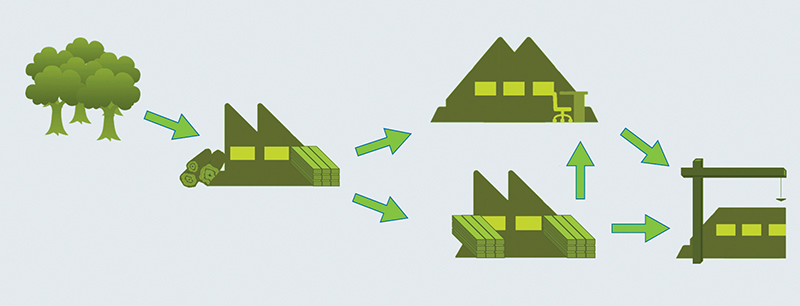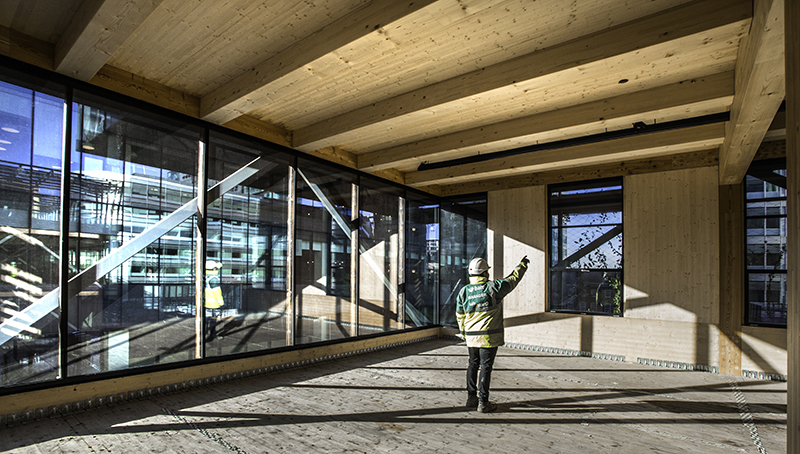Timber has been used in construction for millennia. But to ensure a continued supply, we must procure this valuable resource responsibly. This CPD, produced in conjunction with PEFC UK, explains how this can be achieved.

More than one in five people worldwide, an estimated two billion people, depend on forests and the services they provide for their livelihoods, including food, heat and energy, medicine, wood for building, and other forest products.
Forests are also an integral part of the water and carbon cycles. Every cubic metre of timber can sequester up to a tonne of carbon and play a fundamental role in climate regulation. Yet, in the last two centuries an imbalance has occurred in certain parts of the world, where more timber has been removed than the woodlands can naturally regenerate, causing mass deforestation.
The Food and Agriculture Organisation of the United Nations (FAO) estimates that around 178m ha of forested area has been lost since 1990. Brazil alone is estimated to be losing an area the size of three and a half football pitches every minute. Although nearly half of this loss was due to expanding food and palm oil production, illegal timber harvesting is still a major driver.

The construction industry must therefore ensure all the timber and wood-based products procured through its supply chains is sourced responsibly from well-managed forests.
UK timber market and sources
It is helpful to understand where the timber used on UK construction sites is sourced from, so that the risks associated with illegal and unsustainable practices in some parts of the world can be managed.
The majority of the timber consumed in the UK is softwood, followed by various panel boards such as plywood, MDF and OSB. The vast majority of this material is sourced from the UK and Europe, which are considered low-risk sources (see the Nepcon Timber Risk Map: www.nepcon.org/sourcinghub/timber), however there is a higher risk of illegality in the supply chain for some products from certain countries:
- Over 80% of the 1.5m cu m of plywood used is from higher-risk nations including China, Brazil and parts of Malaysia;
- 5% of the 6.6m cu m of imported softwood is sourced from Russia;
- 13% of the 587,000 cu m of imported hardwood is from tropical sources;
- A growing percentage of MDF is sourced from Russia, Brazil and China.
CPET and certification schemes
In 2004, the UK government set up the Central Point of Expertise on Timber (CPET) following claims by Greenpeace that illegally felled timber had been used on high-profile construction sites, including the Home Office. The UK government’s Definition of Legal and Sustainable for Timber Procurement was subsequently developed, along with the UK Timber Procurement Policy (UK TPP) which states:
- Only timber and wood-derived products originating from an independently verifiable legal and sustainable source will be demanded for use on the government estate;
- Appropriate documentation will be required to prove it;
- It applies to all virgin timber and wood-derived products used on the government estate, including temp-orary site works and material supplied by suppliers.

CPET subsequently developed two routes to demonstrate compliance with the UK TPP:
Category A Evidence – independent, third-party forest certification schemes:
- Programme for the Endorsement of Forest Certification (PEFC);
- Forest Stewardship Council (FSC).
- Category B Evidence – all other forms of evidence including:
- UK Forestry Standard source – Grown in Britain (GiB) certification provides evidence of this;
- Forest Law Enforcement Governance and Trade (FLEGT) licensed timber;
- Compliance with the Framework for Evaluating Category B Evidence.
Of these, only the PEFC, FSC and GiB schemes provide full ‘chain of custody’ to the site of use.
Differences between the schemes
FSC was the first to be established in 1994, and developed principles and criteria based on the UN Agenda 21 non-legally binding Forest Principles.
PEFC was established in 1999, based on principles and criteria recognised by the FAO, which it uses to approve independent national forest standards (eg PEFC Finland, USA’s Sustainable Forest Initiative [SFI], and Canadian Standards Association [CSA]).

The UK Woodland Assurance Standard (UKWAS) is the endorsed standard for both FSC and PEFC in the UK, which means all timber produced under this standard can be dual certified as FSC and PEFC. Grown in Britain adopts the UK Forestry Standard (UKFS) for its minimum criteria, which requires the production of approved Forest Management Plans and associated felling licences to confirm legality and sustainability.
Only around 11% of the world’s forests were certified as of 2019, with 326m ha certified to the PEFC standard, and 200m ha certified to the FSC standard, with around 93m ha dual certified to both PEFC and FSC. Twelve percent of the UK’s 3.19m ha of woodland is certified to the Grown in Britain standard, with 44% certified under UKWAS.
Due to the way the schemes operate, FSC tends to dominate in higher-risk nations, with less developed or no national forest management standard, such as in some South American and African countries and the Far East.
Conversely, as PEFC requires a national forest management standard, PEFC tends to dominate in Europe and North America. However, many countries will have a mix of FSC and PEFC-certified forests. For example, Canada has the largest area of certified woodland in the world, of which 137m ha is PEFC-certified and 51m ha FSC-certified.
Drivers for certification
The UK Timber Procurement Policy has been a key driver for certification, and this was reinforced by the Timber and Timber Products (Placing on the Market) Regulations 2013, which placed additional legal duties on anyone handling wood products to assess the risk that they may have come from an illegal source and act to mitigate that risk. It lists two main types of organisation:
- Operators, such as timber importers, are the first to place timber on the UK market and must ensure they employ a due diligence system to prove legality. A contractor could be an operator if it procures timber directly from a supplier outside the UK.
- Traders, including merchants and contractors, need to keep records of who they procured timber from for five years.

These are available to view online at the relevant certification scheme websites, and should be checked prior to procuring any timber products.
Another driver for construction has been the adoption of responsible timber sourcing by assessment schemes such as BREEAM, CEEQUAL, Ska and LEED.
However, the principal driver for many is avoiding the reputational damage of getting it wrong, and being connected with the illegal timber trade in the press.
Inclusive timber procurement policy
To ensure your supply chain knows your requirements, an inclusive timber procurement policy statement is a must. There are five key elements to a good policy:
- Reference to timber and other wood-based products;
- Definition of scope, including both temporary and permanent works;
- Reference to CPET definition of legal and sustainable;
- Requirement for full chain of custody to the site of use;
- Examples of schemes that meet the criteria.
An example of a responsible sourcing policy statement is outlined below:
“All timber and wood-based products for either temporary or permanent inclusion in the works must be from legal and sustainable sources, as defined by the UK government CPET, and be delivered to site with full chain of custody.
“Chain of custody schemes recognised as meeting the above include:
- Programme for the Endorsement of Forest Certification (PEFC);
- Forest Stewardship Council (FSC); and
- Grown in Britain (GiB).”
Having an inclusive timber procure-ment policy provides contractors with a wider choice of products, ensuring good competition is maintained.
Chain of custody
Chain of custody certification is “a mechanism for tracking certified material from the forest to the final product to ensure that the wood, wood fibre or non-wood forest material contained in the product or product line can be traced back to certified forests”.

How does this work? If we have a forest in the UK certified to UKWAS, logs leaving it can carry a PEFC, FSC and GiB claim. These go through various points in the chain including the sawmill, timber merchant and/or product manufacturer – all of which require certification to the PEFC, FSC and/or GiB chain of custody standards to be able to pass on a PEFC, FSC or GiB claim to the next in the chain.
The timber or product can then be delivered to a construction site with full chain of custody. The site itself does not need to be certified to any standard.
Onsite checks
The key piece of evidence required on site is the timber delivery document, which must contain the following information to confirm a valid claim:
- Supplier’s name and address, which must match those on the certificate;
- Site delivery address;
- Delivery date;
- Correct product description and valid product claim;
- Delivery quantity for each product;
- Supplier’s chain of custody certificate number.
The valid product claims that can be included for each certification scheme are as follows:
- PEFC – ‘100% PEFC Origin’ or ‘xx% PEFC Certified’
- FSC – ‘FSC 100%’, ‘FSC Mix xx%’ or ‘FSC Recycled xx%’
- GiB – ‘GiB-FP’ or ‘GiB-S’.
The minimum percentage claim recommended by CPET is 70% – at least 70% of the material in the product must be from a forest certified by the relevant scheme, with the remaining 30% from another approved legal and sustainable source (eg, a UKFS source).
To help with these onsite checks, PEFC has produced pocket-sized timber checklist cards which are available free of charge from: [email protected].
By ensuring all timber and wood-based products are from certified responsible sources you are helping to ensure we have a sustainable future supply for the projects of the future.
For more information on PEFC visit: www.pefc.co.uk or email Charlie Law, Sustainable Construction Solutions, at [email protected].
Monitoring certified timber on site
Most major contractors require the use of certified timber on their projects to ensure they comply with legal and building certification requirements. But how is this monitored on site?
BAM Construct UK accepts timber certified to the Grown in Britain, PEFC, and FSC standards, and requires all timber to be delivered to site with full chain of custody.
Details of the requirements are included in its Responsible Sourcing Policy and its Supplier Sustainability Requirements document, with copies of chain of custody certificates requested prior to delivery of timber to site. It also requires copies of delivery notes as evidence of chain of custody.
The BAM SMART online portal is used to record delivery note information, and upload a scanned copy as evidence. Information on the delivery note is automatically cross-checked against the information on the centrally held chain of custody certificate for the supplier, to ensure a valid claim can be recorded.
Data for each site can be collated to give a picture for the region and for BAM Construct UK as a whole.
The latest data for 2019 shows that almost 5,000 cu m of timber was delivered to BAM sites, of which over 92% had full chain of custody certification, over 7% was otherwise verified as legal and sustainable or reused, with less than 0.5% missing chain of custody evidence.
This article has been created by Construction Manager in partnership with PEFC UK
Now answer the CPD questions (please note you must register or sign in first):
CPD Module Content
Information in this CPD was correct at the date of publication.


